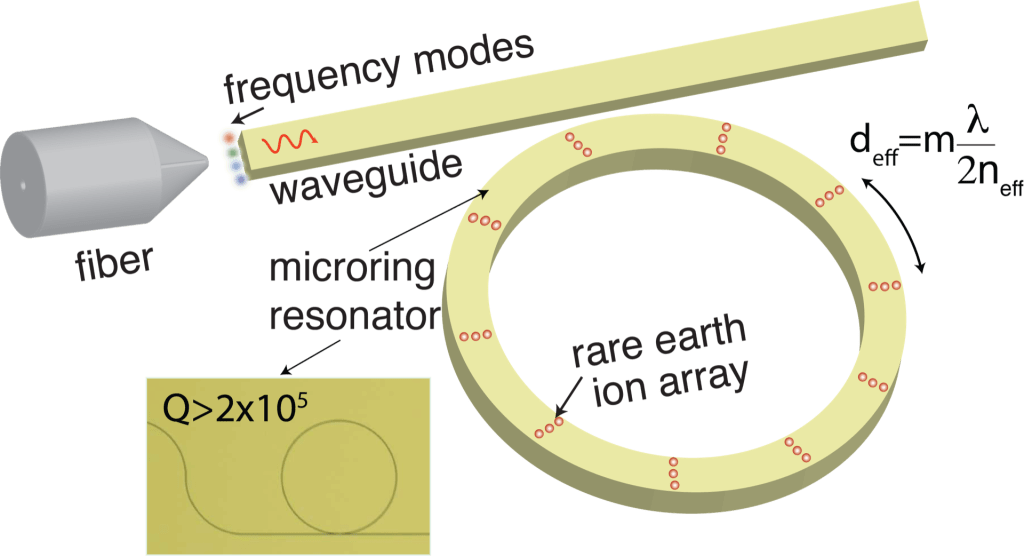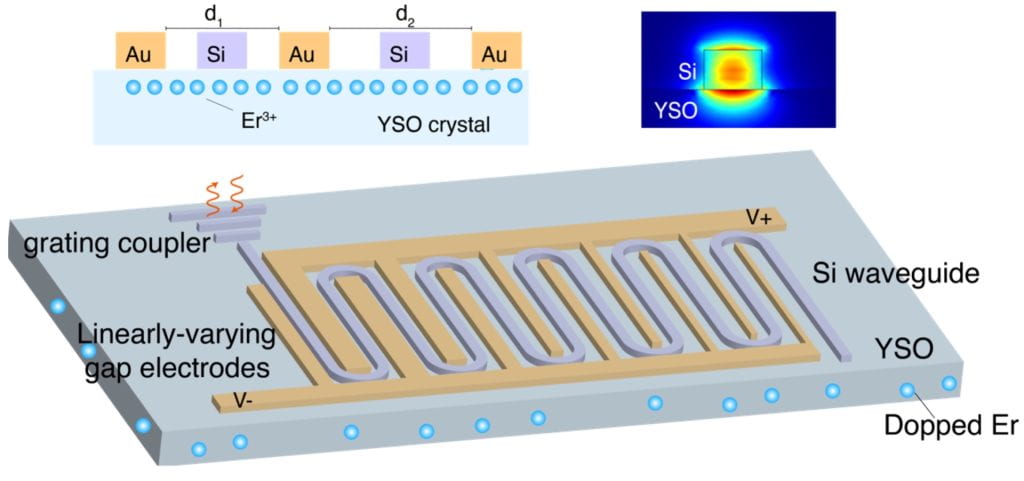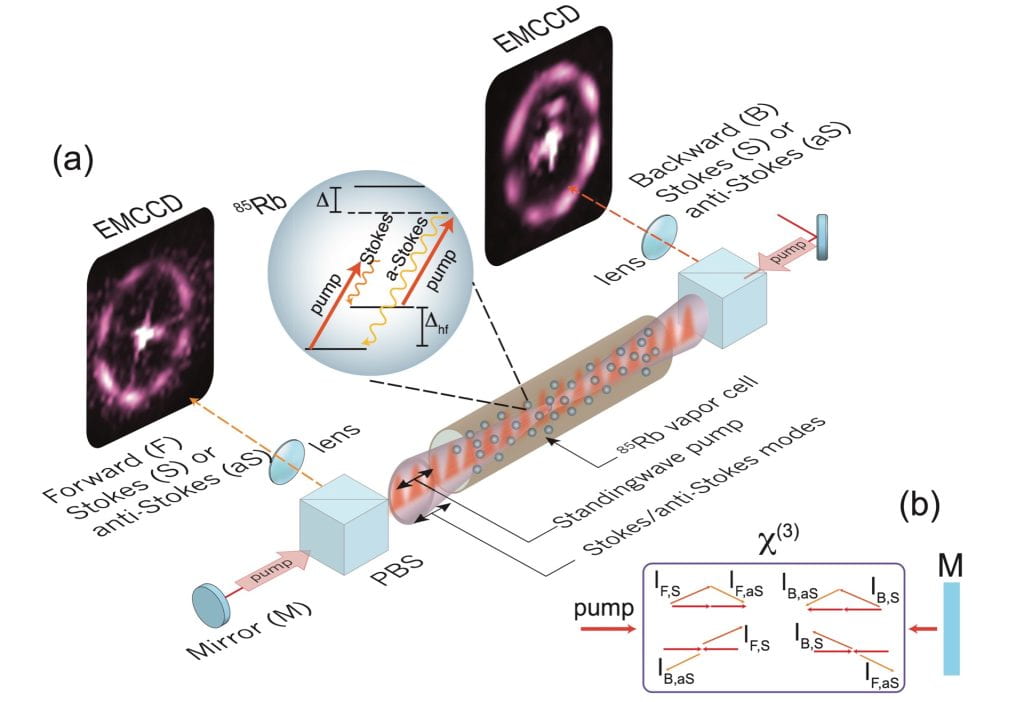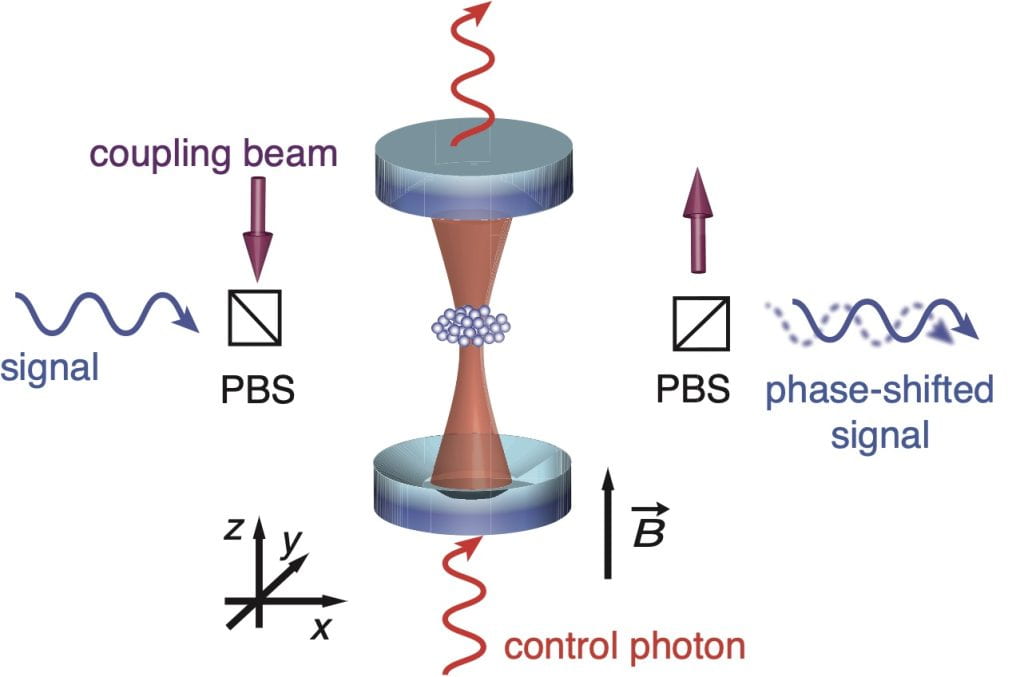Engineering Collective Interactions in Solid-State Arrays.
Our recent research has focused on engineering arrays of active optical centers to effectively control the interaction Hamiltonian between light and matter. The collective interaction of atomic arrays with optical photons offers directionally enhanced absorption or emission, facilitating the development of robust atom-photon interfaces with broad bandwidths. Our study specifically investigates long-range cooperative resonances in an array of rare-earth ions that are controllably implanted into a solid-state photonic resonator. By exploring the enhanced interactions resulting from both cavity-induced Purcell effect and array-induced collective resonances at cryogenic temperatures, we aim to establish a new paradigm for enhanced light-matter interactions. This innovative approach holds promise for suppressing spontaneous emission and ultimately paving the way for novel photonic device advancements.

Selected Publications:
- Trevor Kling and Mahdi Hosseini, “Characteristics of 1D ordered arrays of optical centers in solid-state photonics”, J. of Physics: Photonics (2023).
- Dongmin Pak, Arindam Nandi, Michael Titze, Edward S. Bielejec, Hadiseh Alaeian and Mahdi Hosseini, “Long-range cooperative resonances in rare-earth ion arrays inside photonic resonators” Communications Physics, 5:89 (2022).
- Arindam Nandi, Haechan An, Mahdi Hosseini, “A Coherent Atomic Mirror Formed by Randomly Distributed Ions Inside a Crystal”, Opt. Letts. 46, 1880 (2021).
- Arindam Nandi, Xiaodong Jiang, Dongmin Pak, Daniel Perry, Kyunghun Han, Edward S Bielejec, Yi Xuan, Mahdi Hosseini, “Controlling light emission by engineering atomic geometries in silicon photonics” Opt. Lett. 45 (7) 1631-1634 (2020).
- Keiichiro Furuya, Arindam Nandi, Mahdi Hosseini, “Control of atomic geometry and its effect on photon generation and storage [Invited]”, Opt. Mat. Exp. 10, 577-587 (2020).
Heterogeneous Photonic Integration and Nanofabrication.
Rare earth ions (REIs) in solids have many applications in nonlinear optics including lasers and optical amplifiers due to their stable optical transitions and long lifetimes. REIs also feature long nuclear spin coherence times and weak coupling to external radiation, which are attractive features for applications in quantum information processing. The crystalline solids incorporated with quantum centers such as REIs enable the miniaturization of quantum optical elements which will play a key role in the implementation of future multiplexed quantum optical networks. To date, the integration of nanophotonic resonators on bulk rare earth crystals resulted in the demonstration of quantum storage, single-photon generation, strong atom-photon interactions, and quantum transduction.
Motivated by recent progress in lithium niobate and silicon-photonic nanofabrication, we consider adopting these thin-film photonic platforms as host materials for REIs.

Selected Publications:
- Dongmin Pak, Haechan An, Arindam Nandi, Xiaodong Jiang, Yi Xuan, Mahdi Hosseini, “Ytterbium-implanted photonic resonators based on thin film lithium niobate”, J. of Appl. Phys.128, 084302 (2020).
- Xiaodong Jiang, Dongmin Pak, Arindam Nandi, Yi Xuan, Mahdi Hosseini, “Rare Earth-implanted Lithium Niobate: Properties and On-chip Integration” Appl. Phys. Letts. 115, 071104 (2019).
- Dongmin Pak, Arindam Nandi, Michael Titze, Edward S. Bielejec, Hadiseh Alaeian and Mahdi Hosseini, “Long-range cooperative resonances in rare-earth ion arrays inside photonic resonators” Communications Physics, 5:89 (2022).
Quantum Optical Storage in Atomic Ensembles.
A quantum optical memory should coherently map quantum coherence from an optical field to stationary excitations such as the spin of atoms. The mapping should be reversible, and on-demand, and the process should not add noise to the retrieved optical states. To achieve this, various protocols have been proposed and experimentally realized using atomic systems. As an example, gradient echo memory (GEM) offers controllable and efficient storage in an ensemble of atoms. In this case, a gradient of frequency broadening introduced by an external field ensures that different frequency components of the photon wavepacket are stored at different locations thus printing the phase information in spatial locations. Reversing the slope of the gradient in some sense reverses the phase evolution and leads re-emission of the photon wavepacket from the memory.
We work to implement quantum optical memories in solids and atomic gases using GEM and other echo protocols to allow arbitrary control (spectral, temporal, and spatial) of the stored information. Memories of this kind are the building blocks of future quantum communication networks.

Selected Publications:
• Yisheng Lei, Faezeh Kimiaee, Tian Zhong, Alexander Kuzmich, Christoph Simon and Mahdi Hosseini, “Quantum Optical Memory for Entanglement Distribution”, Optica, 10, 1511-1528 (2023).
• M. Hosseini, B. M. Sparkes, G. Campbell, P. K. Lam and B. C. Buchler, “High efficiency coherent optical memory with warm rubidium vapor”, Nature Communs. 2, 174 (2011).
• M. Hosseini, G. Campbell, B. M. Sparkes, P. K. Lam, and B. C. Buchler, “Unconditional Room Temperature Quantum Memory”, Nature Phys. 7, 794798 (2011).
• M. Hosseini, B. M. Sparkes, G. Hetet, J. J. Longdell, P. K. Lam and B. C. Buchler, “Coherent optical pulse sequencer for quantum applications”, Nature 461 (7261), 241-245 (2009).
• B. M. Sparkes, J. Bernu, M. Hosseini, J. Geng, Q. Glorieux, P. A. Altin, P. K. Lam, N. P. Robins, and B. C. Buchler “Gradient echo memory in an ultra-high optical depth cold atomic ensemble”, New J. Phys. 15, 085027 (2013).
Coherent Optical Levitation of Macroscopic Objects.
We are developing a highly sensitive sensor based on hybrid levitation of milligram-scale mirrors. This platform not only enables fundamental tests (e.g. Schrödinger-Newton equation) but also offers practical applications in precision accelerometry and vibration sensing.
The Schrödinger-Newton equation was proposed as a classical modification to account for gravitational effects in the quantum evolution of massive objects. Detecting deviations from standard linear quantum theory may offer insights into whether parallel realities predicted by quantum mechanics can subtly influence one another—without violating causality.

Selected Publications:
• Xiaodong Jiang and Mahdi Hosseini, “Driven Nonlinear Damping and Mode Coupling in a Superconducting Levitated Magnet”, Phys. Rev. Research 4, 013132 (2022).
• Xiaodong Jiang, Josiah Rudge, and Mahdi Hosseini, “Superconducting Levitation of a mg-Scale Cavity Mirror”, Appl. Phys. Lett. 116, 244103 (2020).
• G. Guccione, M. Hosseini, S. Adlong, M. Johnsson, J. Hope, B. Buchler, P. K. Lam “Scattering-Free Optical Levitation of a Cavity Mirror Using an Optical Spring”, Phys. Rev. Lett. 111, 183001 (2013).
Coherent Optical Sensing and Quantum Light Generation.
In our lab, we investigate atomic, optomechanical, and optical systems to develop exquisite sensors to measure EM fields, force, and temperature in various environments. We use intensity-squeezed states of light generated from a room-temperature atomic gas aiming to perform temperature sensing and thermal imaging of electronic structures beyond the capability of classical systems.

Selected Publications:
• Hamza Ather, Haechan An, Hal Owens, Sami Alajlouni, Ali Shakouri and Mahdi Hosseini, “Quantum Sensing of Thermoreflectivity in Electronics”, Phys. Rev. Appl. 19, 044040 (2023).
• Haechan An, Hal Owens, Hamza Ather, Ali Shakouri and Mahdi Hosseini, “Intensity instability and correlation in amplified multimode wave mixing”, Scientific Reports, 12:14784 (2022).
• Xiaodong Jiang and Mahdi Hosseini, “Driven Nonlinear Damping and Mode Coupling in a Superconducting Levitated Magnet”, Phys. Rev. Research 4, 013132 (2022).
• Xiaodong Jiang, Josiah Rudge, and Mahdi Hosseini, “Superconducting Levitation of a mg-Scale Cavity Mirror”, Appl. Phys. Lett. 116, 244103 (2020).
• Keiichiro Furuya, Mahdi Hosseini, “Memory-based probabilistic amplification of coherent states”,J. Opt. Soc. Am. B. Vol. 36, Issue 12, pp. 3523-3530 (2019).
• M. Hosseini, G. Guccione, H. J. Slatyer, B. C. Buchler and P. K. Lam “Multimode laser cooling and ultra-high sensitivity force sensing with nanowires”, Nature Communs. 5, 4663 (2014).
• G. Guccione, M. Hosseini, S. Adlong, M. Johnsson, J. Hope, B. Buchler, P. K. Lam “Scattering-Free Optical Levitation of a Cavity Mirror Using an Optical Spring”, Phys. Rev. Lett. 111, 183001 (2013).
Cavity Quantum Electrodynamic Interactions.
The strength of interaction between photons and atoms is important for efficient and coherent control of quantum optical information. Interaction can be enhanced by optical resonators to overcome the probabilistic limit in quantum interactions. Such nonlinear interaction is key to deterministic entanglement creation between atomic and photonic qubits. Previously (at MIT), Prof. Hosseini investigated QED interaction of light with an ensemble of laser-cooled atoms inside a high-finesse cavity. Our group is now interested in realizing such interactions in solid-state media.

Selected Publications:
• Yiheng Duan, Mahdi Hosseini, Kristin M. Beck, Vladan Vuletić, “Heralded Interaction Control between Quantum Systems”, Phys. Rev. Lett. 124, 223602, (2020).
• Mahdi Hosseini, Yiheng Duan, Kristin M. Beck, Yu-Ting Chen, Vladan Vuletić, “Cavity cooling of many atoms”, Phys. Rev. Lett. 118, 183601 (2017).
• Kristin M. Beck, Mahdi Hosseini, Yiheng Duan and Vladan Vuletić, “Large conditional single-photon cross-phase modulation”, PNAS, doi:10.1073/pnas.1524117113 (2016)
• M. Hosseini, K. M. Beck, Y. Duan, W. Chen and V. Vuletic “Partially Nondestructive Continuous Detection of Individual Traveling Optical Photons”, Phys. Rev. Lett, 116, 033602 (2016).